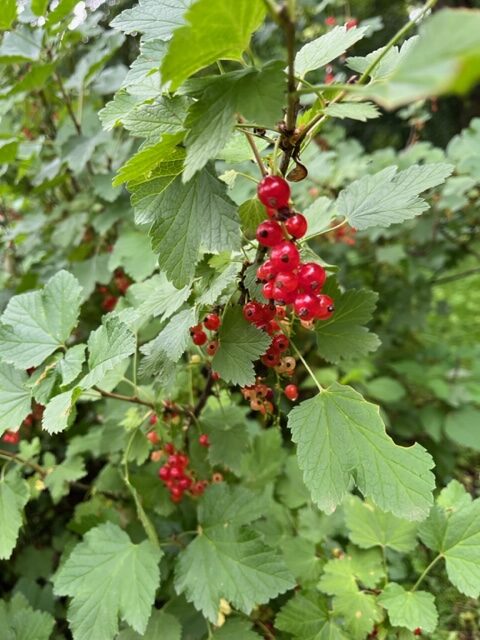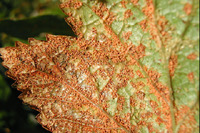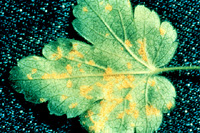


A Guide to Cultivating Currants in Your Midwest Backyard
(from the March 2024 Grapevine)
by Robin Guy
For fruit-growing enthusiasts in the Midwest, few crops offer the versatility, flavor, and beauty of currants. With their vibrant clusters of berries ranging from white to red and pink, currant bushes not only provide a delightful addition to your backyard but also yield bountiful harvests for culinary delights. This will explore the nuances of growing currants in the Midwest region, from selecting the right cultivars to caring for your plants and addressing common challenges like pests and cedar rust.
Choosing the Right Currant Varieties
Before diving into cultivation practices, it’s essential to understand the different types of currants that are available. The three primary types (and examples) are black currants (Ribes nigrum ‘Consort’), white currants (Ribes rubrum ‘White Imperial’), red currants (Ribes rubrum), and pink currants (Ribes rubrum ‘Pink Champagne’). Each variety offers unique flavors and aesthetic appeal, allowing growers to diversify their backyard orchards. When selecting cultivars for your garden, consider factors such as taste preferences, space availability, and local climate conditions.



Propagating Currants
- Cuttings
Propagating currants from hardwood cuttings is a common and relatively straightforward method. You can take hardwood cuttings in late fall or early winter when the bushes are dormant. Select healthy, disease-free stems that are approximately pencil-thickness in diameter and 8-12 inches long. Cut the stems just below a bud at the base and above a bud at the top. Remove any lower buds or side shoots. Plant the cuttings in a prepared nursery bed or directly in the ground, ensuring they are buried to about two-thirds of their length. Keep the soil moist but not waterlogged, and they should root within a few months. - Layering
Another method of propagation is layering, which involves bending a lower branch of a mature currant bush to the ground, making a shallow cut or nick on the underside of the branch, and then covering it with soil. The branch will eventually produce roots at the point where it meets the soil. Once roots have formed, you can sever the rooted branch from the parent plant and transplant it to its desired location. - Division
If you have a mature currant bush that has become overcrowded or you want to increase your stock, you can divide it. This method involves digging up the entire plant and carefully separating the root system into smaller sections, each containing both roots and stems. Replant these sections in prepared soil, ensuring they are watered thoroughly after planting. - Grafting
Grafting is a more advanced propagation technique, and is less commonly used for currants compared to other fruit trees, grafting can be employed to propagate specific cultivars or to create dwarfing rootstocks.
Each propagation method has its advantages and challenges, so choose the one that best suits your skills and resources. Regardless of the method you choose, it’s essential to start with healthy parent plants and provide proper care to ensure the success of your new currant bushes.
Planting Currants in the Midwest
Currants thrive in cool climates with well-drained soil and adequate sunlight. In our area, it’s best to plant currant bushes in early spring or late fall to allow for root establishment before the onset of extreme temperatures. Choose a location with partial shade to protect the plants from scorching summer sun while still providing enough light for fruit production. Currants thrive in well-drained soil that is rich in organic matter and slightly acidic to neutral pH. Ideally, the soil should be loamy and fertile, allowing for good root development and moisture retention without becoming waterlogged. Sandy or sandy-loam soils are often preferred for currant cultivation as they provide adequate drainage, while clay soils can be amended with organic matter to improve drainage and structure.
A soil pH ranging from 5.5 to 7.0 is ideal for currants. You can test the pH of your soil using a soil testing kit available at garden centers or through your local agricultural extension office. If the pH is too low (acidic), you can raise it by incorporating lime into the soil. Conversely, if the pH is too high (alkaline), you can lower it by adding sulfur or acidic organic matter such as pine needles or peat moss. Ensure proper spacing between bushes, typically 4-6 feet apart, to facilitate airflow and minimize the risk of disease.
Caring for Your Currant Plants
Once planted, currant bushes require regular maintenance to ensure optimal growth and productivity. Water the plants deeply and consistently, especially during dry spells, to prevent stress. Mulching around the base of the bushes helps retain soil moisture and suppresses weeds. Additionally, annual pruning is essential to promote airflow, remove dead or diseased wood, and shape the bushes for optimal fruit production. Prune mature bushes in late winter or early spring before new growth emerges.
Fertilizing Currant Bushes
To support healthy growth and abundant fruiting, currant bushes benefit from regular fertilization. Apply a balanced fertilizer in early spring before new growth begins, following the manufacturer’s recommendations for amounts and application frequency. Avoid over-fertilization, as excessive nitrogen can promote lush foliage at the expense of fruit development. Organic options such as compost or well-aged manure can also provide essential nutrients while improving soil structure.
Managing Pests and Diseases
Like any fruit crop, currants are susceptible to pests and diseases that can impact plant health and yield. Common pests include aphids, currant fruit flies, and spider mites, which can be managed through cultural practices, insecticidal soaps, or botanical pesticides. Regular inspection of foliage and berries allows for early detection and intervention against pest infestations.
Common Ways to Consume Currants
Fresh currants are delicious eaten straight off the bush when fully ripe. They have a tart flavor that pairs well with sweeter fruits like strawberries or peaches. Simply rinse the currants under cold water, remove any stems or debris, and enjoy them as a refreshing snack.
In salads, currants can add a burst of flavor and color. Add fresh currants to green salads for a sweet-tart contrast, or mix them with other fruits like oranges and apples for a fruit salad. Their vibrant hue can also enhance the visual appeal of your dishes.
Currants are commonly used in baking to add sweetness and texture to various recipes. They can be incorporated into muffins, scones, cakes, bread, and cookies. Simply fold fresh or dried currants into the batter or dough before baking to infuse your baked goods with their delightful flavor
Currants are excellent for making preserves, jams, and jellies due to their high pectin content. You can cook fresh currants with sugar and a little lemon juice to make a flavorful spread that can be enjoyed on toast, scones, or as a topping for yogurt or ice cream.
Currants can be cooked down into a thick sauce or syrup that can be drizzled over desserts like cheesecake or pancakes. You can also use currant sauce as a glaze for roasted meats such as duck or pork.
Currants can be used to make refreshing beverages like fruit-infused water, lemonade, or cocktails. Muddle fresh currants with herbs like mint and basil, then mix them with sparkling water or alcohol for a flavorful drink.
Dried currants can be enjoyed as a snack on their own or used as a topping for oatmeal, yogurt, or salads. You can also incorporate dried currants into trail mix or granola for an added burst of sweetness. Whether enjoyed fresh, cooked, or dried, currants are a versatile fruit that can elevate a wide range of dishes with their tart, sweet flavor. Experiment with different recipes to discover your favorite way to eat them! Currants offer a tart flavor that goes perfectly in smoothies or milkshakes. Combine low-fat milk, low-fat yogurt or ice cream, and blend with frozen currants and other frozen fruits.

=============================================================
Currants – What they are, What they aren’t, and Why they were Banned in the US
By Bob Walter
Fruits in the Family Grossulariaceae, Genus Ribes are collectively known as currants or gooseberries. The Ribes genus includes about 200 individual species of currants and gooseberries. Among the currants are red, pink, or white currants (Ribes rubrum) and blackcurrants (Ribes nigrum). Currants, especially the blackcurrants, were the cause the 1912 nationwide ban on growing and selling currants in the US. White pines grew across wide areas of North America at that time and these trees were important sources of lumber. In 1900, a species of rust fungus, Cronartium ribicola, was accidentally introduced into America from China. This fungus causes white pine blister rust, a devastating pathogen of white pines. Back to that in a minute.
But first, let’s sort out a bit of confusion about currants. Dried grapes like raisins or sultanas are also commonly called currants. However, they are in the botanical Family Vitaceae. Their Genus and Species designation is Vitis Vinifera. Raisins are usually made from green grapes (Thompson Seedless) and sultanas were originally made from smaller yellow seedless grapes found in Turkey. But today, sultanas and raisins are both usually made from Thompson Seedless green grapes. Raisins are usually brown and sultanas are yellow. These color differences are the result of the drying method used on the grapes and whether or not they were treated with sulfur (yellow sultanas are treated with sulfur, brown raisins are not). In any case, currants made from dried grapes are entirely different from currants in the Ribes genus.
White Pine Blister Rust (WPBR) requires 2 hosts to complete its growth cycle: Pine trees and Ribes. The fungus first infects a white pine tree which releases spores when the fungus is mature. These spores infect nearby Ribes plants. After these spores germinate and mature, they release spores that will then infect white pines and the process goes on, alternating between infecting pine trees and Ribes hosts. Anyone who is familiar with Cedar Apple Rust will recognize that this same pattern of two hosts occurs in that disease too, only the hosts in CAR are cedar trees and apple trees which exchange the Cedar Apple Rust spores. When you look at the leaves of currants that are infected with WPBR, they strongly resemble the leaves of apple trees infected with CAR. The leaves are covered with yellow spots and brown damaged tissue. As an aside, I have had wild gooseberries growing in my yard for many years and have seen their leaves spotted with yellow or brown spots indicating that WPBR is growing there. It’s very easy to recognize.
In response to the WPBR infestation of white pines, in 1912 the federal government quarantined all Ribes plants and berries and supported the eradication of Ribes in regions growing white pines and banned the importation or sale of Ribes berries because they could also carry WPBR. This federal ban was finally lifted in most states in1966, but 4 states still continue the ban and 6-8 additional states limit the selling or growing Ribes depending on how close it occurs to forests of white pines. Illinois and Indiana have no such bans. The reasons for discontinuing the bans are mainly:
- The development of WPBR-resistant varieties of white pine trees, of currants and of gooseberries
- Improved forestry methods for pruning white pine trees to resist the fungus.
Interestingly, many red, white, and pink varieties of currants are naturally resistant to the fungus. Because resistant varieties of blackcurrant have been developed in the years since 1912, WPBR is much less of a problem now than it had been. As a result, currants and gooseberries can now, in most US states, be grown and enjoyed by many.
Sources:
Hansen, Maughan, and Black, Red Currants in the Garden, Utah State Univ. Extension, 2014.
https://digitalcommons.usu.edu/cgi/viewcontent.cgi?article=1631&context=extension_curall
Ribes, Wikipedia, 2024. https://en.wikipedia.org/wiki/Ribes
Otis C. Maloy, White pine blister rust, 2023. Washington State University, Pullman, WA

